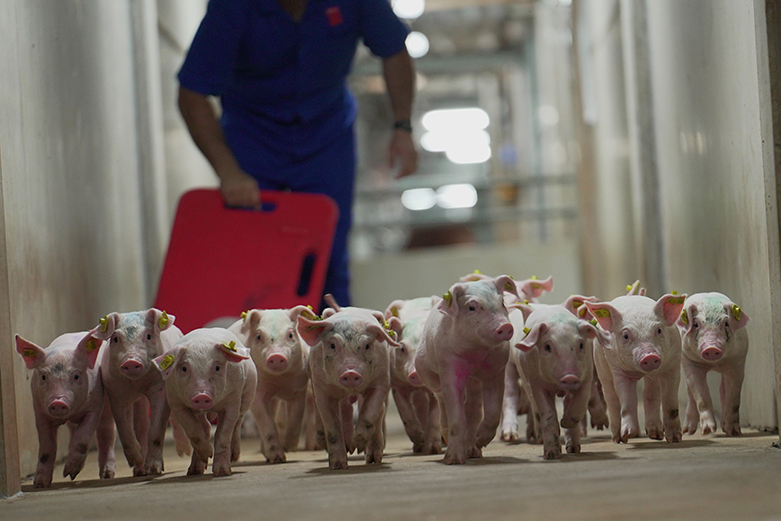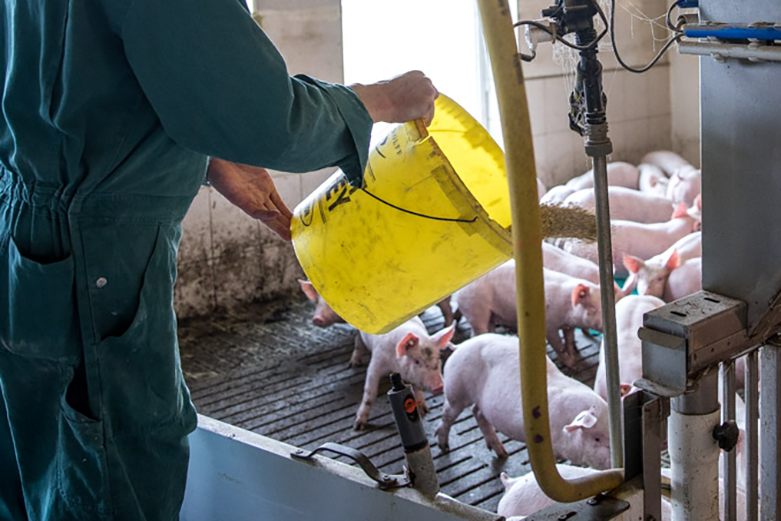WEANING OF PIGS: OPTIMAL MANAGEMENT AND NEW CHALLENGES – an 8-part series
- What happens at weaning
- Objectives at weaning for a sow
- Piglet management around weaning
- Management of piglets after weaning
- Feeding of the sow
- Piglet feeding at weaning
- Age at weaning
- Types of weaning according to the age of the piglet.
The authors:
Emilio Magallón Botaya – Veterinarian specialising in Economics and Pig Production.
Sara Beitia Delgado – Agronomist Engineer – La Almenara Farm
Pablo Magallón Verde – Technical Service PIC
David Roldan Feringan – Veterinarian-Granja La Almenara
Patricia Prieto Martínez – Veterinary Service Inga Food
Images provided by the authors
After weaning, the piglets’ diet is changed from a warm liquid diet (milk) to solid feed. To ensure a good start after weaning, good management during this transitional phase of the piglet is crucial.
Piglet feeding around weaning
Feeding challenges
Sow’s milk is about 85 % water and 15 % dry matter, of which about 25 % is lactose, 40 % fat and 30 % protein. It contains no starch.
The feed, however, is composed of a mixture of animal and vegetable proteins, so that it contains mostly starch instead of lactose and is low in fat compared to the sow’s milk.
In addition, when milk intake is abruptly stopped, the function and structure of the digestive tract changes:
- The height of the microvilli decreases.
- The depth of the crypts increases.
- There is a reduction in absorption capacity because lactase and sucrase enzyme activity decreases.
Poor intestinal absorption of nutrients in the small intestine is often associated with a proliferation of enterotoxigenic bacteria, often accompanied by fermentation of less digestible nutrients in the large intestine.
Therefore, if we do not establish good feeding at weaning, the piglet will suffer fasting, weight loss, diarrhoea, and possible death in the days immediately after weaning.
To counteract all these disadvantages, a suitable feeding programme must be applied so that the piglet preserves its intestinal health and avoids diarrhoea.
In accordance with this problem, and to avoid digestive problems, when formulating diets for piglets we must consider:
- The piglet at weaning has a very high feed efficiency; if it eats it will grow and this will have a very positive repercussion throughout its life.
- Diets with special ingredients considerably increase consumption during the first post-weaning week due to their high palatability and digestibility. These ingredients include pre-cooked cereals, milk proteins, fish meal, simple sugars and porcine plasma.
- The administration of diets with special ingredients should be reduced as soon as possible and in a progressive way, once the piglet reaches good intakes due to the high cost of these diets.
- In general, at weaning, our feeding strategy will be most effective when health, facilities, management, and environmental comfort are adequate.
Main actions
It has been demonstrated in scientific articles, and in daily farm practice, that piglets that have eaten feed in lactation, even in small quantities, adapt better to weaning. It is of course highly recommended to wean piglets with the same feed they ate in the lactation phase (figure 1).

Figure 1.
Piglets “exploring” the feed in the nursery.
In the first 2-3 days it is also essential to give small amounts of fresh feed to the piglets so that they consume it during the day, but without rationing it (with zinc withdrawal this is important by default – prolonged feeding -, or by excess of days with the possibility of feeding too much and triggering diarrhoea). It is also important that they have a sufficient length of feeding trough, with the temporary incorporation of plates or directly in the solid area of the pen, so that they can eat at the same time, just as they did with their mothers. It is highly advisable to administer mash to piglets less than 28 days old, and to small and delayed piglets for 3-4 days post-weaning, no more than 1-2 meals per day and not too dense to avoid scares and problems of over-consumption by the dominant piglets in the pen (figure 2).

Figure 2.
It is recommended to offer mash feed
to piglets weaned at less than 28 days of age.
The feed should be liquid and warm like milk, to achieve a quicker adaptation to the feed.
In this series of articles, in order not to be too long, we will not deal with water consumption, but we must know that it is essential to administer water of biochemical and bacteriological quality, with adequate flow and temperature levels. Water is one of the main nutrients for the piglet. On farms with digestive problems in piglets at weaning, it is advisable to administer water with organic acids that lower the pH to around 5. The imminent ban on the use of zinc oxide in June 2022 and the reduction in the use of antibiotics in post-weaning diets obliges us to work with very well-balanced and specialised formulas for this phase of the piglet’s life.
Nutritional concepts
In the first two weeks post-weaning, special ingredients are needed to increase the palatability and digestibility of the diet. Diets are formulated based on cooked cereals, milk proteins, fish meal, simple sugars, porcine plasma. These diets are more effective the better the management, environmental conditions, and facilities at weaning.
Crude protein and ideal amino acid profile
Piglet diets with high levels of crude protein (CP) predispose to the appearance of colibacillary diarrhoea, so we must work with low levels of CP. Recent work indicates that diets with 17-18% quality CP supplemented with synthetic amino acids are very suitable for weaner diets. However, there is a study (with zinc) by Ian Wellock that showed that protein quality and origin is more important than the percentage of CP. With the commercialisation of isoleucine, valine, histidine, and arginine, it is possible to work with up to 16 % CP in a prestarter on struggling farms without excessively penalising growth.
There are several reasons for the increased risk associated with high protein diets:
- The buffering capacity of proteins that raise intestinal pH.
- Intestinal fermentations caused by high levels of PB and the proliferation of pathogenic bacteria that use protein as a substrate.
- Increased fermentation end products such as ammonia, skatole, phenols and biogenic amines.
CP per se, however, does not necessarily lead to growth of pathogens, especially E. coli. Farm health conditions play an important role and the profile and concentration of PB and amino acids in the diet may vary depending on the health status, environmental conditions, and management of each farm.
Crude fibre and digestible carbohydrates
To maintain gut motility, crude fibre levels should be between 2 and 3%, higher levels limit feed intake. In the early ages, rather than talking about crude fibre, we start to work with the different sources of fibre, although not much is known yet, we talk about soluble and insoluble fibre. At this stage, providing more soluble fibre (beet pulp) is dangerous as it slows down and can cause extravasation of liquids into the intestine. On the other hand, insoluble fibre has a beneficial mechanical entrainment effect, but by speeding up transit and making nutrients less accessible, it decreases digestibility. In a paper by Mollist, it is mentioned that 3-4 times more insoluble fibre than soluble fibre should be used in prestarter. It is possible to work with hemicelluloses that behave like insoluble fibres but are capable of fermenting in the posterior tract, performing this dual function. Certain fibres ferment along the length of the intestine, especially the large intestine, producing volatile fatty acids, which can have a beneficial effect on intestinal health. Among the most interesting volatile fatty acids is butyric acid, which improves the structure and function of the colon. Fermentable fibre influences the composition and activity of the microbiota, as it offers some protection against post-weaning colibacillosis. In this respect, diets with beet pulp are of interest, but only with 1% in prestarter and 2% in starter diets and never in lacto starter.
Benefits of fermentable fibre
- Reduces ammonia levels, which is irritating to the intestinal mucosa.
- Increases lactic acid in ileum.
- Increases volatile fatty acid production in colon.
Animal plasma
Animal plasma is a product containing polyamines and immunoglobulins that promote intestinal growth. Its incorporation in prestarter feeds improves daily growth and feed conversion rates:
- It is a rich source of available amino acids.
- It improves the palatability of the diet.
- It supplies the piglet with a high percentage of active immunoglobulins that increase its defences against pathogenic micro-organisms.
The effect is greater if the plasma is of porcine origin than of bovine origin.
Inclusion percentages vary from 3 to 6 % in the first feed. Better results are obtained with feed in meal than in pellets, as the pelleting temperature affects the immunoglobulins in the plasma. When plasma is used in the first feed, it is advisable to reduce it progressively in subsequent feeds so as not to penalise consumption.
It is very important to know the origin and provenance of the plasma and the treatments it has received to avoid transmitting serious infectious diseases such as PED (Porcine Epidemic Diarrhoea) or ASF (African Swine Fever).
Other nutritional concepts
The aim of incorporating organic acids into the diet is to reduce the pH at stomach level (stomach pH is 2.5 – 4.0, but in piglets it is around 4.5 – 7.0) to aid protein digestion, control the proliferation of pathogenic microbiota and prevent the occurrence of diarrhoea. This is important in zinc-free diets as the piglet has an immature digestive system and is not able to acidify the stomach sufficiently.
The inclusion of acidifiers in feed improves animal performance, especially when feeding vegetable protein-based diets with low milk protein content. To avoid penalising the efficacy of acidifiers, it is important to provide diets with low buffering capacity. It is therefore important to limit the protein content and to reduce the level of calcium and other minerals as much as possible.
A high level of calcium implies a higher buffering capacity of the diet, which neutralises and limits the piglet’s stomach acidification capacity and compromises the efficacy of these acidifiers added to the feed.
Lactose acidification of prestarter and starter feeds, apart from being very interesting as a source of energy, will improve the palatability and digestibility of the feed, which has a beneficial effect on feed intake, weight gain and improved feed conversion, especially in the first two weeks post-weaning.
High levels of lactose induce a significant growth of beneficial gut microbiota (Lactobacilli and Bifidobacteria), which creates a competitive environment that protects the gut microbiota and limits the colonisation of pathogens such as E. coli, Cloctridium spp. and Salmonella spp.
The addition of lactose can be partially replaced by other sugars such as dextrose, but not more than 1-2% to avoid undesirable fermentation.
Meeting the challenge
As we have seen throughout the chapter, the separation of the piglet from its mother is a huge challenge for the animal from many points of view. It is one of the most problematic and controversial phases.
The piglet changes from a liquid feed with a certain composition to a solid feed with a different composition. Added to this is the stress of separation from the mother and the change of environment, which is now more competitive. Achieving high intakes in sows before weaning will be of great benefit to all.
This series of articles was first published in the professional journal SUIS.



